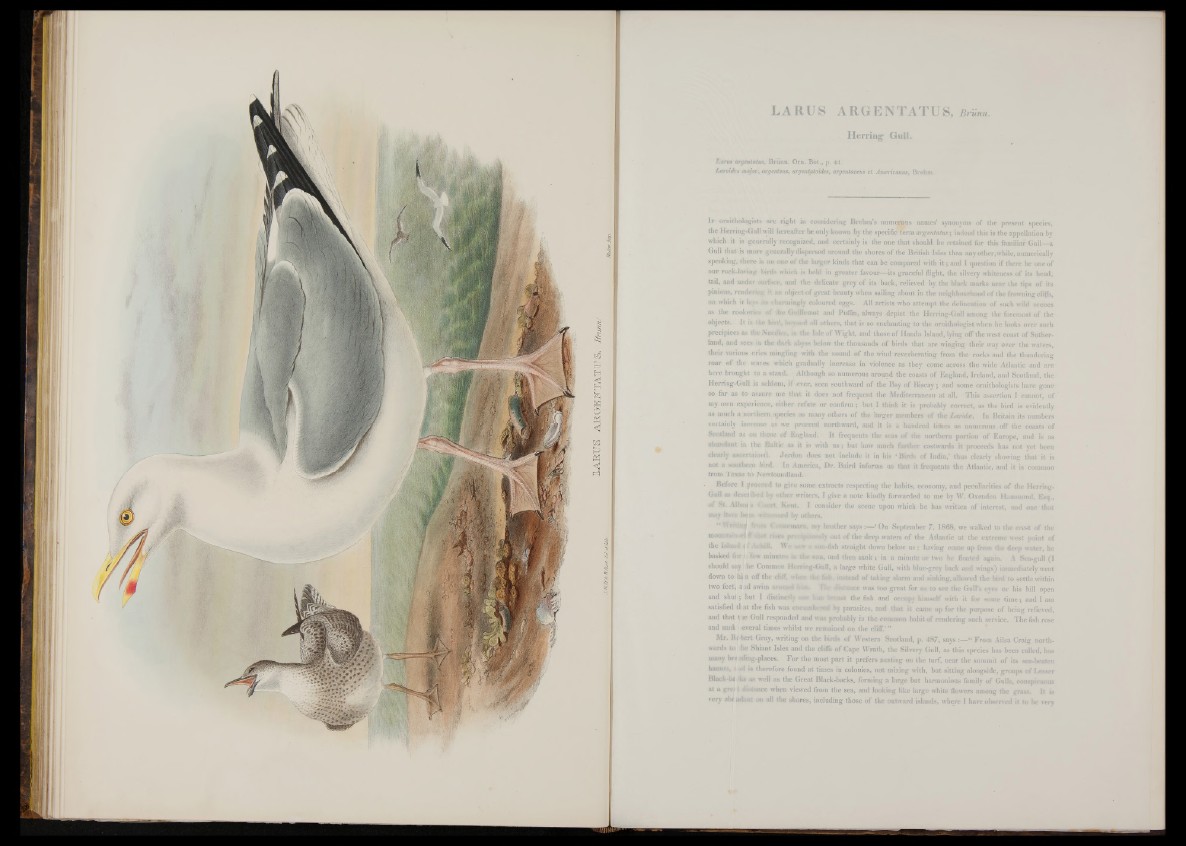
LARUS ARG EN TATU S, Brünn.
H e rrin g Gull.
Lortts argcntatux, Brünn. Om. Bot., p. 44.
Lamidas major, argenteus, argentatoides, argentaceus et Americanos, Bre
Ip ornithologists are right in considering Brehm’s numerous names' synonyms o f the present species,
the Herring-Gull will hereafter be only known by the specific term argentatm; indeed this is the appellation by
which it is generally recognized, and certainly is the one that should be retained for this familiar Gull— a
Gull that is more generally dispersed around the shores o f the British Isles than any other, while, numerically
speaking, there is no one o f the larger kinds that can be compared with it ; and I question if there be one of
our rock-loving f ed s which is held in greater favour— its graceful flight, the silvery whiteness o f its head,
tail, and under «•»'face, and the delicate grey of its back, relieved by the black marks near the tips of its
pinions, rendering: w an object o f great beauty when sailing about in the neighbourhood o f the frowning cliffs,
on which it lay« m charmingly coloured eggs. All artists who attempt the delineation o f such wild scenes
as the rookeries n i v\he Guillemot and Puffin, always depict the Herring-Gull among the foremost of the
objects. It is the beyond all others, that is so enchanting to the ornithologist when be looks over such
precipices as the Need his, in the Isle o f Wight, and those of Hauda Island, lying off the west coast o f Sutherland,
and sees in the dark abyss below the thousands o f birds that are winging their way over the waters,
their various cries mingling with the sound o f the wind reverberating from the rocks and the thundering
roar o f the waves which gradually increase in violence as they come across the wide Atlantic and are
here brought to a stand. Although so numerous around the coasts o f England, Ireland, and Scotland, the
Herring-Gull is seldom, if\ever, seen southward o f the Bay o f Biscay; and some ornithologists have gone
so far as to assure me tfot it does not frequent the Mediterranean at all. This assertion I cannot, of
my own experience, either refute or confirm; but I think it is probably correct, as the bird is evidently
as much a northern species as many others o f the larger members o f the Laruke. Xii Britain its numbers
certainly increase as we proceed northward, and it is a hundred times as numerous off the coasts of
Scotland as on those o f England. It frequents the seas o f the northern portion o f Europe, and is as
abundant in the ljSaltic as it is with u s ; but how much further eastwards it proceeds has not yet been
dearly ascertained. Jerdon does not include it in his * Birds of India/ thus clearly showing that it is
not a southern bird. In America, Dr. Baird informs us that it frequents the Atlantic, and it is common
from Texas to Newfoundland.
Before I ifroeeed to give some extracts respecting the habits, economy, and peculiarities o f the Herring-
Gull as described by other writers, I give a note kindly forwarded to me by W. Oxenden Hammond, Esq.,
of St. Albas! s i twit* Kent. I consider the scene upon which he has written o f interest, and one that
may have bel m «ilRMiMft by others.
* Wri-wtrf $r*m i < -ovwemani, my brother says ‘ On September 7, 1868, we walked to the crest o f the
mottnt5j»n-cfl # tfepft rise« precipitously out o f the deep waters o f the Atlantic at the extreme west point of
the Island < f Aehtti. W <• a «un-fish straight down below us : having come op from the deep water, he
basked for , few minutes in the sun, and then sank ; in a minute or two he floated again. A Sea-gull (I
should say I he Common Herring-Gull, a large white Gull, with blue-grey back and wings) immediately went
down to hij« off the cliff, when the fob, instead o f taking alarm and sinking, allowed the bird to settle within
two feet, ij id swim annmd hiw*. .1: :v distance was too great for us to see the Gull’s eves or his bill open
and shu|; but I distinctly Ues breast the fish and occupy himself with it for some time; and I am
satisfied tl at the fish was encumbered by parasites, and that it came up for the purpose o f being relieved,
and that t le Gull responded and was probably in the common habit o f rendering such service. The fish rose
and sanli j everal times whilst we remained on the cliff.’ ”
Mr. ijj bert Gray, writing on the birds o f Western Scotland, p. 487, says “ From Ailsa Craig northwards
tejj be Shiant Isles and the cliffs o f Cape Wrath, the Silvery Gull, as this species has been called, has
many brjl iding-places. For the most part it prefers nesting on the turf, near the summit o f its sea-beaten
haunts, j ad is therefore found at times in colonies, not mixing with, but sitting alongside, groups o f Lesser
Rlaek-ba 4ss as well as the Great Black-backs, forming a large but harmonious family o f Gulls, conspicuous
at a grej t distance when viewed from the sea, and looking like large white flowers among the grass. It is
very ab( wdant on all the shores, including those o f the outward islands, where I have observed it to be very